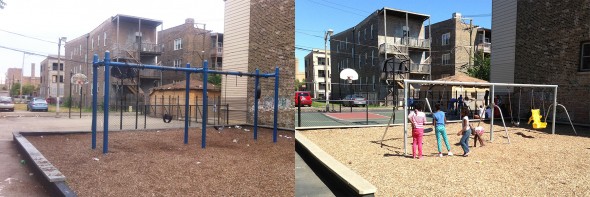Where do the children play? In renovated playgrounds, study says
Playground renovation, as led by community groups, creates neighborhood parks that draw more visitors and encourage more active pursuits than parks with older, worn-out playgrounds, according to a report by University of Illinois at Chicago researchers who studied Chicago parks.

Millard Park in Chicago’s Lawndale neighborhood before playlot renovations in 2013 (left) and after renovations in 2014.
“We know that residents of neighborhoods with parks and other recreational facilities are, in general, more physically active than people who live in communities without such resources,” says Sandy Slater, research associate professor of health policy and administration in the UIC School of Public Health and lead author of the study, published in a special supplement of the journal Environment and Behavior sponsored by Active Living Research.
“We wanted to know if changing one park feature – the playground – had an impact on the number of people visiting the parks, and if the way they used the parks and the playground itself changed.”
Regular physical activity has been linked to lowered risk for obesity, cardiac disease, diabetes and cancer.
“Neighborhoods without places to go to play or exercise are at a significant health disadvantage,” said Slater, who is also a fellow in the UIC Institute for Health Research and Policy. Neighborhoods whose playgrounds are in disrepair face the same disadvantage, she added.
Slater and her colleagues wanted to know whether involving community groups in the playground renovation process – to pick a design, helping to install the playground surface, and maintaining the renovated playground – affected overall use of the entire park.
In the summer and fall of 2013 and 2014, they collected data on 39 Chicago Park District playgrounds before and after renovation under the Chicago Plays! program, a plan to rejuvenate 300 playgrounds across Chicago over five years. Parks were chosen in 33 of Chicago’s 77 neighborhoods.
The researchers also compared observations – over two days, including a weekend and weekday – from 39 “matching” parks with similar but unrefurbished playgrounds. They recorded the number of park users and the level of physical activity the visitors engaged in. They revisited each park a year later, for three days.
In total, 14,586 people were observed – an average of 33 per day at each park. Of those, 15 visitors on average engaged in moderate-to-vigorous activity, while 18 remained sedentary, mostly by sitting.
From one year to the next, parks with renovated playgrounds saw usage increase from an average of 36 visitors per day to 42. Parks whose playgrounds had not been renovated saw visits drop from an average of 29 per day to 27.
Parks with renovated playgrounds also saw a year-to-year increase in visitors pursuing moderate-to-vigorous activity, from an average of 17 active users per day to 25. Active visitors also went up in parks without renovated playgrounds, but only from an average of 12 per day to 15.
“To renovate playgrounds takes significant capital investment,” said Slater. “If we have more evidence that refurbished playgrounds with strong community support see more visitors after renovations, and those visitors are reaping the benefits of increased physical activity, then those dollars are well-spent.”
Slater acknowledged that it’s hard to disentangle the role of community involvement in boosting park utilization from the attraction due to an improved playground itself. But she believes that neighborhoods that are invested in their new parks use them more. She and her team plan to develop a guide to help Chicago’s communities improve their parks.
Oksana Pugach, Tracy Lin and Anita Bontu of the UIC Institute for Health Research and Policy are co-authors on the paper. The research is a project of the Illinois Prevention Research Center, which engages communities to improve health through environmental and policy changes, and is funded through a cooperative agreement from the U.S. Centers for Disease Control and Prevention (U48-DP005010) and administered by the UIC Institute for Health Research and Policy. Other support came from a grant from UIC’s Institute for Policy and Civic Engagement.
